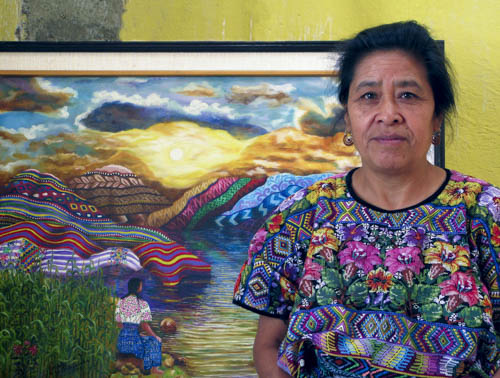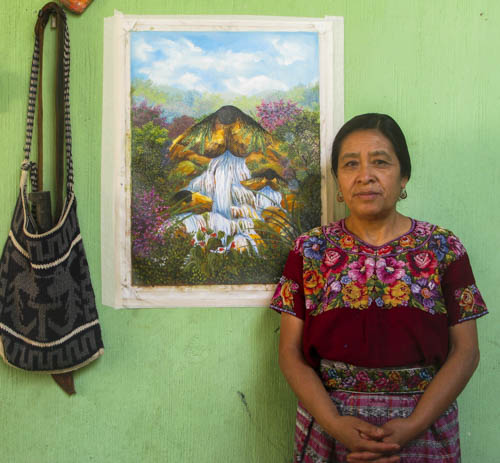Paula Nicho Cúmez
Part IBy Joseph Johnston When Paula Nicho joined the woman’s painting collective, she did not know Salvador Cúmez. Paula was impressed by the intelligence and kindness of Salvador, and the two were married. Paula proved to be his star pupil. Paula Nicho Cúmez was a skilled weaver before she took up painting, and her themes often draw upon her weaving background. Many of her images are drawn from her dreams. She also has a strong belief in the equality of all people—women with men, and the Maya with everyone else. When she began painting, her themes and ideas stood out from all the other painters, but her ability to apply paint to the canvas lagged behind. Fortunately she gained skill the more that she painted. Paula is lucky to be married to Salvador Cúmez. Her fame has eclipsed his, and whereas most male Maya artists would feel threatened by having a wife who is more successful, Salvador is philosophical about it. He says: “I enjoyed my time in the spotlight, now it is Paula’s turn.” |
 |
Paula Nicho Cúmez with her painting "Cánto a la Naturaleza" (Song to Nature). Part II: My LifeBy Paula Nicho Cúmez (Translated from the Spanish) I come from a family of very limited means. My papá worked in the fields, where he grew corn, beans, and vegetables. He always brought us with him to the field to work. I’m grateful to my mamá, who taught me to weave ever since I was very little, and this is how we daughters learned this art. From this experience I learned about the combination of colors and different forms. Later, I had the good fortune to meet Salvador, my husband, who encouraged me to do something different. At that time in San Juan Comalapa, only men were painters. And so I searched for my own style. Before me there was a generation of women painters who were the daughters of the first Maya painters. I am part of a second generation that came up, and together we formed a group of women painters. Each of us had a specialty, and our own individual style. So it became known that in Comalapa there was a group of women painters, and that it was no longer just men. This has been quite a struggle right up to the present day, but we all—men and women alike—have the right to dedicate ourselves to art. During the 1970s and 80s we were faced with difficult situations in life. We could no longer go out to work in the field [due to the armed conflict]. Thus we began to paint in a group and then we went to exhibitions in different galleries in Guatemala City. However, my compańeras didn’t want to change their style. They continued to paint landscapes, still lifes, and primitivism—which are still the themes that the men paint. I like to experience the life of women as workers, because every being, man or woman, carries his or her own history. Music, as well, is a medium of inspiration. And nature inspires me to create works, as do my cosmovision or world view, and my culture. In my community many people see me as different because of the themes I choose and my way of painting a work, but I like to do things in my own way. I paint for love of art, and my paintings are not commercial. I am mindful that the Creators have given me a lot of energy, and that is what I infuse into my works. |
 |
Paula Nicho Cúmez in her studio, a tiny room above a small shop in San Juan Comalapa where
the family sells art materials. At a late date, this painting fell creating a large
tear in the canvas. Part III: About My PaintingsBy Paula Nicho Cúmez (Translated from the Spanish) Our Mother Earth has three energies: Ruk’ux ya’el, Heart of the Water; Ruk’ux ulew, the Heart of the Earth, and Ruk’ux kaj, the Heart of the Sky. These are the energies that protect us and provide us with security and alimentation, the way a mother does. The heart of the sky and the heart of the earth are connected by an eye. From them come all the forms of life. They symbolize our creation. Heart of the Water. Our mother earth is generous and wants to see us grow. She gives us water from her breast and lets us live in her body as her memory. We all have dreams, some of the good, some of them bad. Dreams are messages sent by God, el ajaw. Places in the mind free us or pressure us with words that form images that speak to us, and guide us on every path. Sometimes I dream of flying. I have never known where the flight will carry me. I just let myself be lifted up and I paint, and I feel that I am beyond the universe. Each woman has her story engraved upon hear body. The future is a weight, an uncertain landscape that we must lift up in order for us to rise, to move forward. A woman receives and celebrates the energies of a new era, a new B’aktun. She is in front of a place in memory so that she will not forget her past, and she will carry with her the energies of a new era. The woman dances with her heart when dawn comes. She celebrates its colors and dances with the ancestors—the grandfathers and grandmothers. In the songs of the birds and with the flowers she has a presentiment of the beginning of a new time/era. She leaves her sorrows behind. The mountains talk and communicate with the creators, just as we do. They understand many languages. Fire, music, water, air, painting and dance—it is all a song of gratitude to the life which is given to us. Our Mother Earth is in danger because of the destruction that human beings cause. All beings have life and communicate in various ways to tell us that they don’t want to die. Now they are left without a home, without water, without life. To me, Guatemala has been drowned, as in the sea. I feel that the only thing that remains for us is to once again weave the country, without forgetting our histories, which we carry in our skin and in our voices. Many people begin to fly, seeking a dream. But on the way they change or they need to abandon their past, leaving behind them things that are essential in their lives, such as the heat of their land, their native dress, their voice, their dreams. Many of them will never return. |
 |
Paula with her painting "Ru K'ux Ya" (Heart of the Water). Paula's paintings are always filled with symbolism. In this
painting about a natural spring, the rocks from which the water flows look like the breasts of women, symbolizing mother
earth providing for us. |






